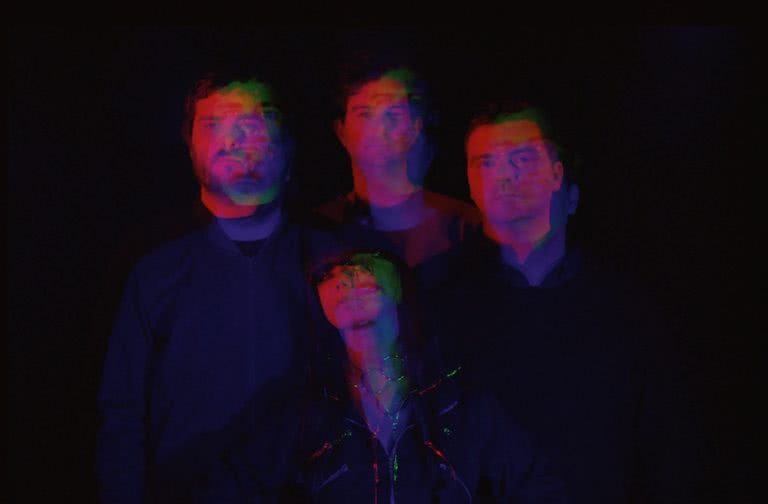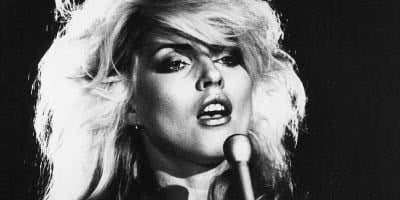When it comes to dread-soaked synth-punk, few bands do it better than NUN. But fans of the Melbourne quartet’s self-titled 2014 album might be need time to adjust to the band’s long-gestating follow-up, The Dome. Where the first record was harsh and abrasive, the second is surprisingly poppy and streamlined. Even frontwoman Jenny Branagan’s baleful vocals feel more clean-cut and accessible.
Yet, rather than sacrifice the pitch-black mood of earlier tracks like ‘Uri Geller’ and ‘Cronenberg’, The Dome exploits the thrilling dichotomy of brighter, punchier songs that dispense regular doses of fear and paranoia. “Sometimes that has more strength to it,” says Branagan by phone. “It’s unsettling in its own way. I find this album really sad, grim, and bleak.”
That perspective isn’t shared by bandmates Steven Harris, Hugh Young and Tom Hardisty, who brandish various synths and drum machines. “[They] feel very differently,” she confirms. “They feel that this is a very bright and uplifting thing. We all come at it in a different way.”
Watch the video for ‘Pick Up the Phone’ by NUN below

It’s easy to see both sides. For all the wonky drag of the slow-burn ‘Pick Up the Phone’, or the sustained fever-dream vibe of seven-minute closer ‘Debris’, ‘Another Year’ pairs Branagan’s protest-like lyrics to gleaming, pinging melodies. Even opener ‘Wake in Fright’, with its unmistakable nightmare mantras, feels strangely empowering, while ‘Can’t Chain’ is an outright pop anthem that manages to top the first album’s fist-pumping single ‘Evoke the Sleep’.
But again tapping that paradox of dark and light, Branagan says ‘Can’t Chain’ was written in response to a friend’s suicide attempt. Even the titular hook – “Can’t chain these morons down” – was a blackly comic way of saying you can’t truly hold on to someone who doesn’t want to be here. “You’re wanting to keep your friend safe and happy,” she explains, “but at the end of the day, what control do you have over another person’s choice?”
As for the sample at the end of the song, it’s from the 1972 BBC mini-series Ways of Seeing, written by the late English academic John Berger. Branagan regularly makes such mood-setting interludes for NUN, and she’s recently turned her hand to music videos. She’s also responsible for the concept of the new album’s unsettling black-and-white cover art, which shows a male figure in jeans, runners and T-shirt facing off against an enormous eye in front of a star-pricked night sky. She collaborated on the cover with Per Bystrom, who drew the character, and graphic designer Luke Fraser, who tied it all together.
“I had a really clear idea of what it should be,” says Branagan. “I wanted it to look like a weird disco record, but at the same time [express] the concept I was exploring within. The infrastructure was based on old psychology stuff from the ’70s, which I often use in NUN: amazing, out-there, really insensitive ads for American drugs for depression or anxiety. I very much wanted to have that feeling of the ego looking at itself and screaming.”
Watch the video for ‘Turning Out’ by NUN below

And there’s no missing the inspiration of 1971’s cult classic Australian film Wake in Fright – based on Kenneth Cook’s equally disturbing novel – on the song of the same name. Branagan, who was born in Ireland and has spent only part of her life living in Australia, finds herself drawn to the “feeling of eeriness and otherness” of that movie and also 1975’s Picnic at Hanging Rock.
The four-year drought between albums, meanwhile, can be credited in part to the band’s unique way of working. After writing the songs, the members play them live extensively “before even thinking about recording them,” admits Branagan. And while The Dome was essentially recorded in five days at a holiday house in Victoria’s coastal village of Fairhaven, the band stepped away from it before listening to it individually to see what they each wanted to change.
It’s also tempting to cite the members’ full slates. Hardisty also plays in Woollen Kits and sometimes Constant Mongrel and Terry, in addition to recording bands, while Steven Harris has a solo project and Hugh Young plays in Constant Mongrel. Branagan is half of the bass-heavy duo Vacuum, who are working on a 12-inch EP and video at the moment. And everyone in NUN works full-time, with Branagan staying very busy as Writers Services Rep for APRA AMCOS.
tTo fit the new album’s smoother sheen, Branagan made a point to approach her singing differently. In contrast to what she calls the “internal and muddy” atmosphere of their debut, she wanted to match The Dome’s “sharper [and] more glassy” sound. What resulted is by turns foreboding and welcoming, often within the same thought. And though it was a challenge to stretch herself vocally, she had help from Young, who sang in the Australian Boys Choir as a child.
Anyone who has seen NUN knows that Branagan is a prowling, almost intimidating live presence who never stays still. She recounts her parents finally watching her sing with the band, telling her afterwards that it was a bit scary. But that’s all part of the unique foursome’s visceral layering of pop impulses and darker portent.
“It’s just what comes out,” she confesses. “My instrument in NUN is my voice, and I need helping getting that out. So my body just follows.”
The Dome is out now.




































